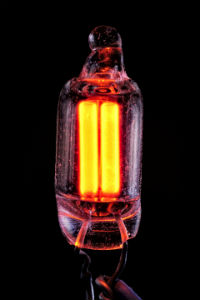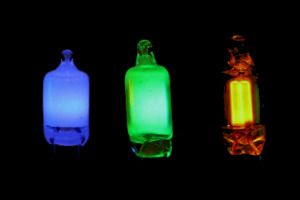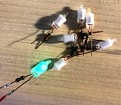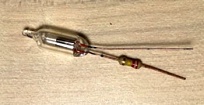 A very frequent question amongst fans of flip clocks, can be paraphrased: "Wouldn't it be better just to replace those old orange lights in flip clocks with an LED?"
A very frequent question amongst fans of flip clocks, can be paraphrased: "Wouldn't it be better just to replace those old orange lights in flip clocks with an LED?"
That's for you to decide, but as for me and many other collectors of vintage flip clocks, the short answer is "no". The long answer is " #$@&%*! NO!" No it would not be better. It’d be about as better as removing the flip clock mechanism and replacing it with an electronic digital clock, - just because they’re more accurate and efficient.
The reasons that I personally continue to use the neon glow bulbs are many:
1. I want to keep a vintage clock as original as possible.
2. The warm orange glow perfectly suits these vintage clocks and it is quite pleasant at night - very easy to wake up to.
3. Putting in an LED requires a DC source - this will require installation of a converter or pulling DC off the circuit board (causing possible performance issues).
4. It's easier!
5. It's Retro.
Why Neon Glow Bulbs are Awesome
They are true neon lights. You can't get much more vintage than that! The technology has been around since 1917 and was used extensively in small appliances and other applications throughout the 1970s (the era of the flip clock).

Classification of the little neon bulb
The neon glow lamp is classified as a low pressure discharge lamp. This kind of bulb is generally called a CCFL (cold cathode fluorescent lamp). Historically, the type of CCFL having a tube diameter less than 15mm is specifically designated as a “Neon Lamp” regardless of the actual gas composition.1
The Workings of the Neon Glow Lamp
The neon glow bulb (also known as a neon glow lamp) consists of two electrodes positioned in a sealed glass bulb which contains a "noble gas mixture" (usually mostly neon, of course).2 The noble gases include the gaseous elements helium, neon, argon, krypton, xenon, and the radioactive radon. Under standard conditions, they are all odorless, colorless, monatomic gases3with very low chemical reactivity. Neon has about two-thirds the density of air.
 Neon glow bulbs run on a low current (normally in the 0.1 to 10 mA range) and on a relatively high voltage for a little bulb (50-220 volts). This makes them perfect for running off of mains current (household current) making them ideal as a lamp to indicate that a circuit is powered - that's why they're often called "indicator lamps."
Neon glow bulbs run on a low current (normally in the 0.1 to 10 mA range) and on a relatively high voltage for a little bulb (50-220 volts). This makes them perfect for running off of mains current (household current) making them ideal as a lamp to indicate that a circuit is powered - that's why they're often called "indicator lamps."
During manufacture the air inside the bulb is evacuated and bulb is filled with mixture of low pressure gases, often approximately 99% neon and 1% helium or argon - this particular mixture is referred to as a "Penning mixture."4
Inside the bulb, surrounded by the noble gas(s) are two metal electrodes often composed of nickel or molybdenum, at times a barium or strontium layer may be added.
When an alternating current flows through the bulb an orangish glow appears around the negative electrode - the electrical current causing the gas itself to ionize and emit light (instead of the filament emitting light as it glows hot as it does in an incandescent light). As you know, alternating current ... well it alternates, so the two electrodes quickly flash light back and forth with the cycling of the current (at a rate of 50 Hz or fifty times a second in most of the world and 60 Hz here in North America). While you would expect a flicker (there is one) our eyes cannot pick this up - so all we see is the steady orange glow.
It's better to burn out ... than fade away5
Or so classic rockers (according to their lyrics) would have us believe. But not in my opinion. The proponents of LEDs often say something to the effect "LEDs are better ... they last forever". Ah Hem. Forever is a long time, my friend. No, LEDs do not last forever. Yes they are long lasting and more efficient than a neon glow bulb. But a neon glow lamp can last decades, and the energy cost, honestly, is not that significant. The neon glow bullb usually just gradually fades (instead of flashing rapidly or just stopping like an LED will eventually).
 While the typical color of the light of a neon glow lamp is orange, other colors (usually green or blue) can be produced. This can be done by using a combination of gases with a main component of the gas Argon. This gas emits light in the UV range that can interact with special coatings placed on the inside of the glass bulb. Interestingly, when not energized, these bulbs appear white due to the coating. A few of the Panasonic flip clock radios use these type bulbs.
While the typical color of the light of a neon glow lamp is orange, other colors (usually green or blue) can be produced. This can be done by using a combination of gases with a main component of the gas Argon. This gas emits light in the UV range that can interact with special coatings placed on the inside of the glass bulb. Interestingly, when not energized, these bulbs appear white due to the coating. A few of the Panasonic flip clock radios use these type bulbs.
So ... it's up to you. LED or neon. And I promise not to judge you either way!

More Details
There are many miniature neon bulbs types - the first five on the list below being the most commonly seen in flip clocks:
- A1B
- C2A (NE-2H)
- A2B (NE-2V)
- A3C (NE-2U)
- A1A (NE-2)
- ----
- B2A (NE-51H)
- B1A (NE-51)
- C9A (NE-2J)
- A1H
- B7A (NE-45)
- A9A (NE-2E)
- C7A (NE-2D)
- B9A (NE-48)
 As mentioned in the discussion above, the neon glow lamps use straight AC current. But it is crucial that you make sure that the proper resistor is placed in line between the bulb and the current. Only one leg of the glow bulb has to have a resistor in place. You'll have to find out what size resistor is needed by reading the specifications regarding the specific bulb that your are considering. Sometimes, online sellers include the resistors with the purchase and you will have to soldier it to the bulb properly. On some eBay listings the bulb already comes with the resistor in place.
As mentioned in the discussion above, the neon glow lamps use straight AC current. But it is crucial that you make sure that the proper resistor is placed in line between the bulb and the current. Only one leg of the glow bulb has to have a resistor in place. You'll have to find out what size resistor is needed by reading the specifications regarding the specific bulb that your are considering. Sometimes, online sellers include the resistors with the purchase and you will have to soldier it to the bulb properly. On some eBay listings the bulb already comes with the resistor in place.
If you're repairing a clock, you often can just simply replace the bulb (soldiering it into place) and using the resistor that is already there. However, I personally always get a new resistor and start fresh. If you use the wrong resistor for the bulb you'll either end up with a dim bulb or a bulb that is running to hot and which could cause problems, but for sure will not last as long as it would with the proper resistor.

bulb with in-line resistor in place.
Some online sources of Neon Glow Bulbs
North America
Memotronics.com - C2A Neon Glow Bulb>
Replacement Neon Lamps & Light Bulbs
All Electronics - NE-2 Neon Lamp
Australia / New Zealand
jaycar products
to discuss this information please go to the Forum Thread
References:
1. Neon and Argon Lamps - https://edisontechcenter.org/NeonLamps.html (accessed 1/19/2020)
2. Neon glow lamps: more than simple light sources - https://www.giangrandi.ch/electronics/neon/neon.shtml (accessed 1/19/2020). This is a highly recommended article from which which the bulk of the information above was obtained.
3. Definition: Monatomic gas - https://en.wikipedia.org/wiki/Monatomic_gas (accessed 1/19/2020)
4. Definition: Penning Mixture - https://en.wikipedia.org/wiki/Penning_mixture (accessed 1/19/2020)

5. "Rock of Ages" - by Def Leppard - https://www.youtube.com/watch?v=uXFxPN7Sqxo (accessed 1/19/2020)
from the 1983 album Pyromania. The song begins with a German-like phrase, "Gunter glieben glauten globen".
According to the Def Leppard FAQ, These four words are actually just German sounding gibberish, spoken by producer Mutt Lange during one of the later takes of the song. Instead of the standard "One, two, three, four" he simply started saying nonsense words instead, and they ended up keeping this particular utterance on this song for a laugh. As the start of the song, Elliott says the lines, "All right/I've got something to say/It's better to burn out/Than to fade away"; the second two lines originated from Neil Young's song "My My, Hey Hey". Def Leppard's version was quoted in the 1985 movie Highlander by the film's villain, the Kurgan. Young's two line version would later become immortalized in rock history when it was used in the suicide note of Kurt Cobain.
